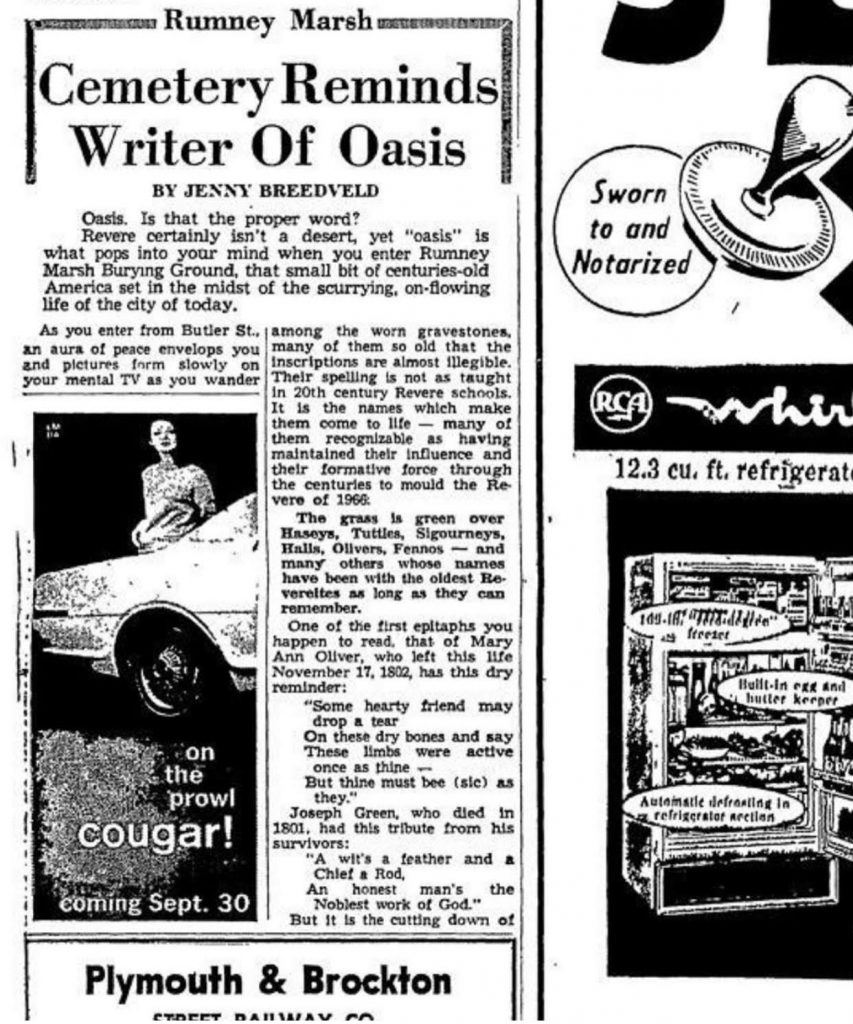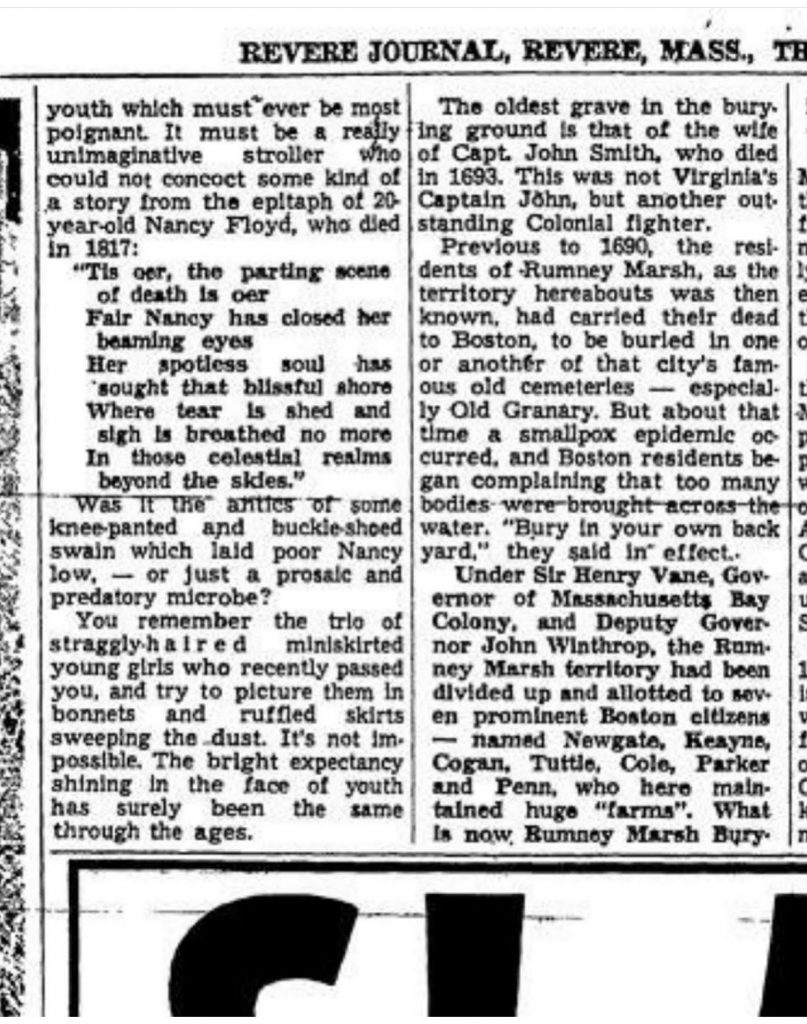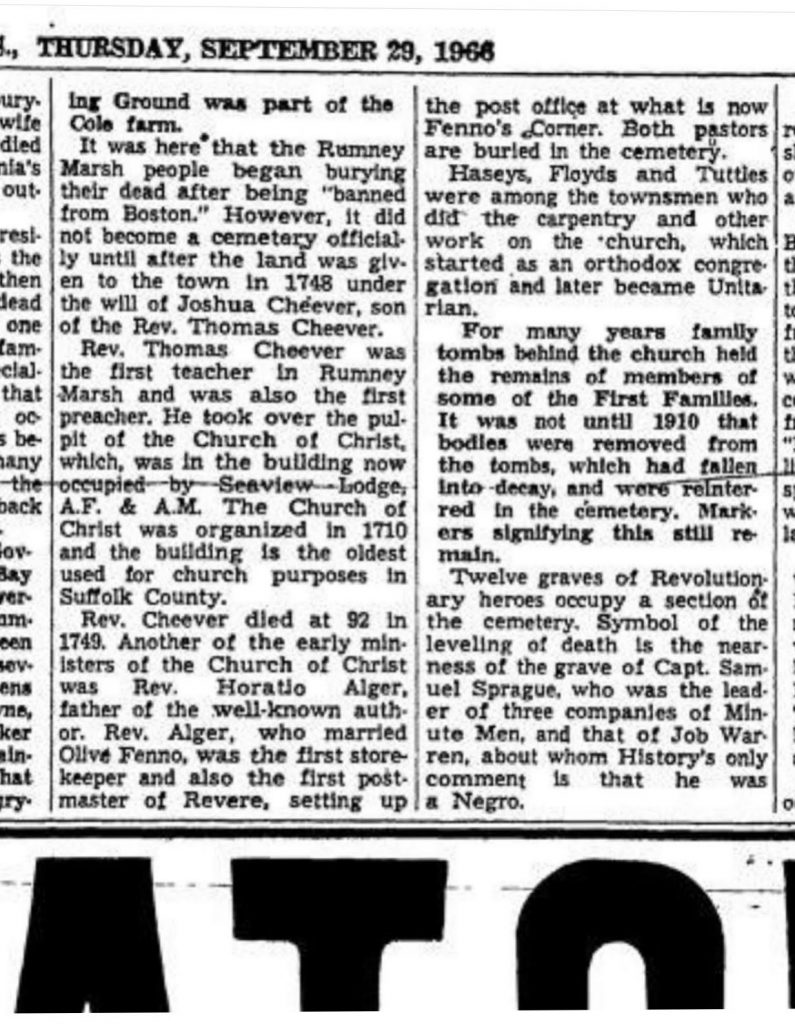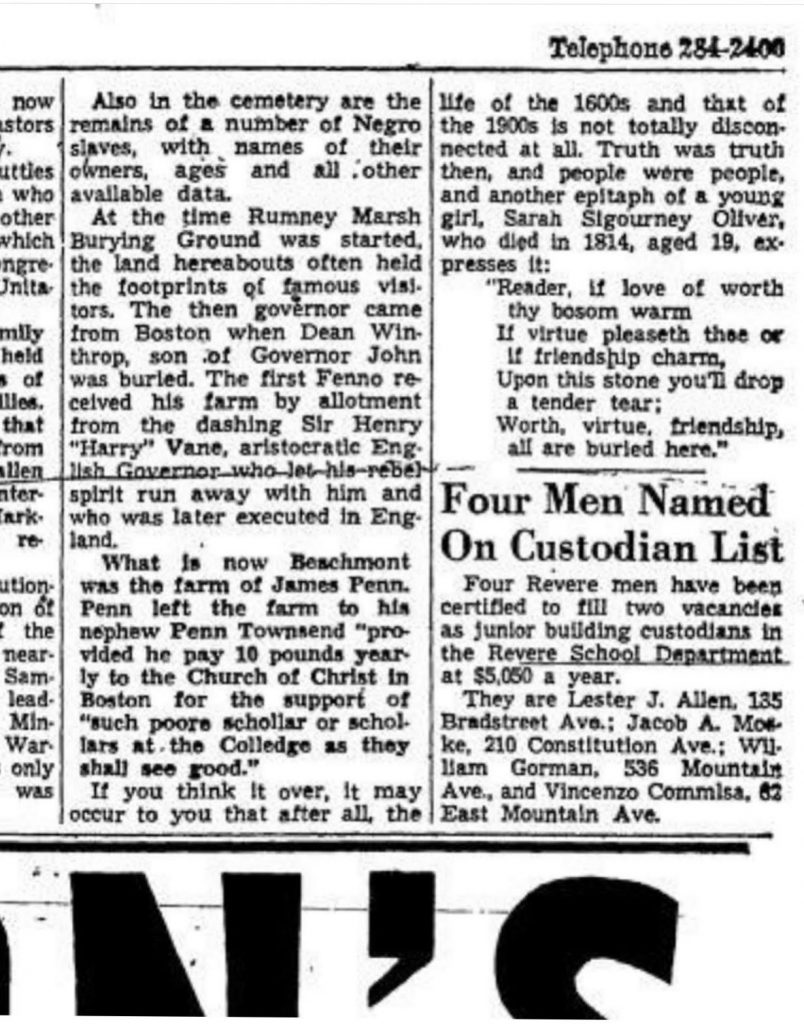Cemetery Reminds Writer of Oasis
By Jenny Breedveld
Oasis. Is that the proper word?
Revere certainly isn’t a desert, yet “oasis” is what pops into your mind when you enter Rumney Marsh Burying Ground1“burying” and “burial” seem to have been used interchangeably over the years, that small bit of centuries-old America set in the midst of the scurrying, on-flowing life of the city today.
As you enter from Butler St., an aura of peace envelops you and pictures form slowly on your mental TV as you wander among the worn gravestones, many of them so old that the inscriptions are almost illegible. Their spelling is not as taught in 20th century Revere schools. It is the names which make them come to life – many of them recognizable as having maintained their influence and their formative force through the centuries to mould the Revere of 1966.
The grass is green over Haseys, Tuttles, Sigourneys, Halls, Olivers, Fennos2We are unaware of any records of Fennos being buried in RMBG – and many others whose names have been with the oldest Revereites as long as they can remember.
One of the first epitaphs you happen to read, that of Mary Ann Oliver3Mary Ann Oliver’s stone was recently discovered in at least 3 pieces. We’re in the process of trying to fix it., who left this life November 17, 1802, has this dry reminder:
Some hearty friend may drop a tear
On these dry bones and say
These limbs were active once as thine
But thine must bee as they.
Joseph Green, who died in 1801, had this tribute from his survivors:
A wit’s a feather and a Chief a Rod,
An honest man’s the Noblest work of God
But it is the cutting down of youth which must ever be most poignant. It must be a really unimaginative stroller who could not concoct some kind of a story from the epitaph of 20-year old Nancy Floyd, who died in 1817:
Tis oer, the parting scene of death is oer
Fair Nancy has closed her beaming eyes
Her spotless soul has sought that blissful shore
Where tear is shed and sigh is breathed no more
In those celestial realms beyond the skies
Was it the antics of some knee-panted and buckle-shoed swain which laid poor Nancy low, or just a prosaic and predatory microbe?
You remember the trio of straggly-haired miniskirted youg girls who recently passed you, and try to picture them in bonnets and ruffled skirts weeping the dust. It’s not impossible. The bright expectancy of youth has surely been the same through the ages.
The oldest grave in the burying ground is that of the wife of Capt. John Smith4Mary Smith, whose footstone still stands, who died in 1693. This was not Virginia’s Captain John, but another outstanding Colonial fighter.
Previous to 1690, the residents of Rumney Marsh, as the territory hereabouts was then known, had carried their dead to Boston, to be buried in one or another of that city’s famous old cemeteries – especially Old Granary5The Granary Burying Ground on Tremont Street contains Paul Revere, John Hancock, Crispus Attucks, and other important figures from early American history. But about that time a smallpox epidemic occurred, and Boston residents began complaining that too many bodies were brought across the water. “Bury in your own back yard,” they said in effect.
Under Sir Henry Vane, Governor of Massachusetts Bay Colony, and Deputy Governor John Winthrop, the Rumney Marsh territory had been divided up and allotted to seven prominent Boston citizens – named Newgate, Keayne, Cogan, Tuttle, Cole, Parker, and Penn, who here maintained huge “farms.” What is now Rumney Marsh Burying Ground was part of the Cole farm.
It was here that the Rumney Marsh people began burying their dead after being “banned from Boston.” However, it did not become a cemetery officially until after the land was given to the town in 1748 under the will of Joshua Cheever, son of the Rev. Thomas Cheever.
Rev. Thomas Cheever was the first teacher in Rumney Marsh and was also the first preacher. He took over the pulpit of the Church of Christ, which, was in the building now occupied by Seaview Lodge, A.F. and A.M6The corner of Eustis and Beach Streets. The Church of Christ was organized in 1710 and the building is the oldest used for church purposes in Suffolk County.
Rev. Cheever died at 92 in 1749. Another of the early ministers of Church of Christ was Rev. Horatio Alger, father of the well-known author. Rev. Alger, who married Olive Fenno, was the first store-keeper and also the first post-master of Revere, setting up the post office at what is now Fenno’s Corner7The corner of Beach Street and Broadway, across from the motorcycle dealer. Both pastors are buried in the cemetery8While Rev. Cheever is definitely in RMBG, Rev. Alger is in fact buried in Natick..
Haseys, Floyds, and Tuttles were among the townsmen who did the carpentry and other work on the church, which started as an orthodox congregation and later became Unitarian.
For many years family tombs behind held the remains of members of some of the First Families. It was not until 1910 that bodies were removed from the tombs, which had fallen into decay, and were reinterred in the cemetery. Markers signifying this still remain.
Twelve graves of Revolutionary heroes occupy a section of the cemetery. Symbol of the leveling of death is the nearness of the grave of Capt. Samuel Sprague, who was the leader of three companies of Minute Men, and that of Job Warren, about whom History’s only comment is that he was a Negro9There is a lot going on in this paragraph – there is no cluster of Revolutionary War heroes in RMBG, so I think the author is mistakenly referring to the Civil War lot. Captain Sprague isn’t really near the Civil War Lot, but Job Warrow (whose last name is sometimes recorded as Warren) is. The historical record has much more to say about him, which you can read about in the Slave burials blog post on this site..
Also in the cemetery are the remains of a number of Negro slaves, with names of their owners, ages and all other available data.
At the time Rumney Marsh Burying Ground was started, the land hereabouts often held the footprints of famous visitors. The then governor came from Boston when Dean Winthrop, son of Governor John was buried10Salem Witch Trial judge Samuel Sewall attended as well. The first Fenno received his allotment from the dashing Sir Henry “Harry” Vane, aristocratic English governor who let his rebel spirit run away with him and who was later executed in England11Vane was briefly a Governor of the Massachusetts Bay Colony, Revere’s Vane Street is named after him.
What is now Beachmont was the farm of James Penn. Penn left the farm to his nephew Penn Townsend “provided he pay 10 pounds yearly to the Church of Christ in Boston for the support of “such poore schollar or schollars at the Colledge as they shall see good.”
If you think it over, it may occur to you that after all, the life of the 1600s and that of the 1900s is not totally disconnected at all. Truth was truth then, and people were people, and another epitaph of a young girl, Sarah Sigourney Oliver, who died in 1814, aged 19, expresses it:
Reader, if love of worth thy bosom warm
If virtue pleaseth thee or if friendship charm,
Upon this stone you’ll drop a tender tear;
Worth, virtue, friendship, all are buried here




